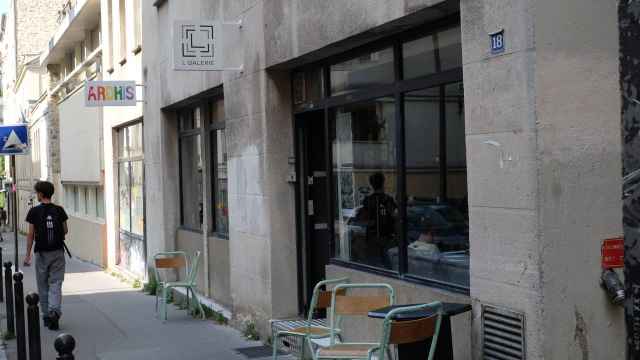I wonder. Did the photograph heading this article chase off half my readers? Or did it double the number?
This is something that has bothered me for years, ever since the genre of commercial theater began to flex its muscles in Moscow 12 to 14 years ago. How do the advertisements publicizing commercial shows work? Do they really attract people?
Speaking for myself alone, they scare the hell out of me. When I run across these ads in various publications, a shiver runs down my spine, I close my eyes, swallow hard and turn the page as fast as I can. I cannot possibly imagine being induced to see a show on the basis of one of these ads.
I must be wrong, however. Every year the number of these ads grows. This is because the number of these commercial shows &mdash always comedies, always ending happily &mdash continues to grow. Now there is cause and effect at work here. These ads and the number of these shows increase for one reason and one reason only: Because their audience keeps growing with them.
Ergo, indeed I am wrong.
Nevertheless, I am going to declare this right now: The vast majority of these advertisements are absolutely hideous. Forget art. Forget subtlety. Let's just talk basic design.
Look at the complex of ads above taken from the magazine Teatralnaya Afisha (Theater Marquee) for shows produced by the LeKur Theater Agency. Everything is static. Faces or bodies are lined up in rows. Shows are presented in boxes. Even the words inside the ads are printed in their own boxes. Typefaces are chaotically different among the different ads, and within each ad they often clash. Color schemes are crass or nearly nonexistent.
Aesthetically, if I may so express myself in this situation, these ads promise familiarity, clarity and simplicity. Everything about them screams to a reader: "Fear not! Ye shall not be challenged! Ye shall have all as ye wish it, as ye know it, and as ye love it. We shall tickle your funny bone as often as possible, and maybe even another part or two of your body. But never shall ye be asked to think or truly to feel! Your instincts shall be satisfied, your brain shall rest!"
Then we come to what is depicted. Everybody is either happy or surprised. Sometimes, as with the actor at the top of the left-hand, full-page ad for a show called "A Snazzy Wedding," they are both happy and surprised. Now isn't that promising?
A goofy facial expression is a big plus in these ads. Look at the photo in the lower left corner of the right page. Here we have two famous, highly-accomplished, well-respected actors, Sergei Makovetsky and Tatyana Dogileva. They look like they were caught unawares by their souvenir-hunting next-door neighbor as they walked out of their apartment in the morning to take out the trash.
Could that be the point? Is this the aesthetic of the Flickr age? The worse the better. The clumsier the merrier. Because it reminds us of all those bad photos we take all the time. I was at a Patti Smith concert at Moscow's B2 club a couple of years ago. Patti was berating her audience for uploading every picture they get of her on their cell phones to Flickr. "Can't you guys throw the bad ones out before you put those things up?" she roared.
Of course a little bit of skin never hurt an advertisement. "A Snazzy Wedding" promises us a love quadrangle with the possibility that four actors will get up from under that sheet in nothing but their birthday suits.
But let's leave sex alone. Because what really gets me in this ad are the faces. Every actor in this collage is doing exactly what they are taught not to do in acting school, but what every actor must do if he or she performs in a TV sitcom &mdash they are "performing with their faces." One plays intrigue. Another plays satisfaction. Another &mdash seduction, and still another &mdash surprise. It's all cut-and-dried, two-dimensional, flat and obvious. This ad is the perfect example of the "televisionization" of Russian theater.
These ads are appealing to audiences that actually prefer television to theater. In short, they are selling theater down the river. It is as if they are suggesting, "If you don't like all that messy theater stuff, come see our shows. We'll feed you entertainment in one big, happy package."
One final note: Don't get me wrong. The proliferation of shows like this is a sign of Russian theater's health. There are audiences for just about every style of theater you can imagine.
If you want gritty, challenging work, you might head for Teatr.doc or the Playwright and Director Center. If you want to have a gauntlet figuratively thrown at your feet you might attend the shows of Kama Ginkas or Nikolai Roshchin. A theater like Konstantin Raikin's Satirikon tends to combine the best of two worlds &mdash experimental and extremely high-quality pop theater.
You'll see none of that at most of Moscow's commercial shows. Be forewarned. The advertisements are telling you that right up front.
A Message from The Moscow Times:
Dear readers,
We are facing unprecedented challenges. Russia's Prosecutor General's Office has designated The Moscow Times as an "undesirable" organization, criminalizing our work and putting our staff at risk of prosecution. This follows our earlier unjust labeling as a "foreign agent."
These actions are direct attempts to silence independent journalism in Russia. The authorities claim our work "discredits the decisions of the Russian leadership." We see things differently: we strive to provide accurate, unbiased reporting on Russia.
We, the journalists of The Moscow Times, refuse to be silenced. But to continue our work, we need your help.
Your support, no matter how small, makes a world of difference. If you can, please support us monthly starting from just $2. It's quick to set up, and every contribution makes a significant impact.
By supporting The Moscow Times, you're defending open, independent journalism in the face of repression. Thank you for standing with us.
Remind me later.






